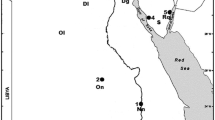Abstract
A set of 60 random primers was used to analyse 11accessions from six taxa of Mentha developed byCIMAP. These accessions were maintained in the nationalgene bank for medicinal and aromatic plants at CIMAP.A total of 630 bands could be detected as amplifiedproducts upon PCR amplification, out of which 589 werepolymorphic (93.5%). Further analysis of these RAPDprofiles for band similarity indices clearlydifferentiated five of the Mentha arvensis L.accessions from the rest. Among two accessions of Mentha spicata L. CIMAP/C33 could bedistinguished from CIMAP/C32. Mentha × gracilis Sole cv. cardiaca showed a muchhigher similarity with Mentha spicata L. as wellas Mentha arvensis L. which amongst themselvesshowed rather a greater distance indicating that Mentha × gracilis Sole cv. cardiaca might have evolved as a natural hybridbetween M arvensis L. and M. spicataL. In terms of uniqueness of amplified bands fordeveloping RAPD markers, it was observed that at taxalevel 298 bands were unique to one of the six taxa,singly amounting to 47.3% of total amplifiedfragments. Primers MAP 10 and 17 produced polymorphismonly in case of M. spicata L. and Menthaspicata L. cv. viridis while MAP 08 producedpolymorphic bands in all 4 other species than thesetwo. Similarly unique patterns were observeddifferentiating all six species and could be used asRAPD markers for differentiating Mentha species.
Similar content being viewed by others
References
Ambasta, S.P., 1986. The useful plants of India. Publication and Information Directorate (CSIR), New Delhi, India.
Baslas, R.K., 1970. Studies on the influence of various factors on the essential oil from the plants of Mentha piperita. Flav India 1: 185–187.
Chandrashekhar, P.J. & H.T. Nguyen, 1993. Application of RAPD technique for the detection of polymorphisms among wild and cultivated tetraploid wheats. Theor Appl Genet 36: 602–609.
Doyle, J.J. & J.L. Doyle, 1987. Method of isolation of plant DNA from fresh tissue. Phytochem Bull 19: 11.
Harley, R.M., 1963. Taxonomic studies in the genus Mentha. D. Phil. Thesis. Oxford University, England.
Harley, R.M. & C.A. Brighton, 1977. Chromosome numbers in the genus Mentha. J Linn Soc Bot 74: 71–96.
Howel, E.C., H.J. Newbury, R.L. Swennen, L.A. Withers & B.V. Ford-Lloyd, 1994. The use of RAPD for identifying and classifying Musa germplasm. Genome 37: 328–332.
Hu, J. & L.F. Quiros, 1991. Identification of broccoli and cauliflower cultivars with RAPD markers. Plant Cell Rep 10: 505–511.
Ikeda, N, 1961. Thermetological investigation of genus Mentha by means of cytogenetics. Fac Agr Okayama Univ, Okayama, Japan, p. 264.
Irwin, S.V., P. Kaufusi, K. Banks, R. de la Pena & J.J. Cho, 1998. Molecular characterisation of taro (Colocasia esculenta) using RAPD markers. Euphytica 99: 183–189.
Jain, A., S. Bhatia, S.S. Banga, S. Prakash & M. Laxmikumaran, 1994. Potential use of RAPD technique to study the genetic diversity in Indian mustard (Brassica juncea) and its relationship to heterosis. Theor Appl Genet 88: 116–122.
Lincoln, D.E., M.J. Murray & B.M. Lawrence, 1986. Chemical composition and genetic basis for isopinocamphone chemotypes of Mentha citrata hybrids. Phytochemistry 25: 1857–1863.
Mackill, D.J., 1995. Classifying japonica rice cultivars with RAPD markers. Crop Sci 35: 889–894.
Murray, M.J., D.E. Lincoln & P.M. Marble, 1972. Oil composition of Mentha aquatica _ Mentha spicata F1 hybrids in relation to the origin of Mentha piperita. Can J Genet Cytol 14: 13–29.
Nei, N. & W. Li, 1979. Mathematical model for studying genetic variation in terms of restriction endonucleases. Proc Natl Acad Sci (USA) 76: 5269–5273.
Orozco-Castillo, C., K.J. Chalmers, R. Waugh & W. Powell, 1994. Detection of genetic diversity and selective gene introgression in coffee using RAPD markers. Theor Appl Genet 87: 934–940.
Shoyama, Y., X. Zhu, R. Nakai, S. Shiraishi & H. Kohda, 1997. Micropropagation of Panax notoginseng by somatic embryogenesis and RAPD analysis of regenerated plantlets. Plant Cell Rep 16: 450–453.
Williams, C.E. & D.A. St-Clair, 1993. Phenetic relationship and levels of variability detected by RFLP and random amplified DNA analysis of cultivated and wild accessions of Lycopersicon esculentum. Genome 36: 619–630.
Williams, J.G.K., A.R. Kubelik, K.J. Levak, J.A. Rafalski & S.V. Tingey, 1990. DNA polymorphism amplification by arbitrary primers are useful as genetic markers. Nucl Acids Res 18: 6531–6535.
Yu, K.F. & K.P. Pauls, 1993. Rapid estimation of genetic relatedness among heterogeneous populations of alfa-alfa by random amplification of bulked genomic DNA samples. Theor Appl Genet 86: 788–794.
Author information
Authors and Affiliations
Rights and permissions
About this article
Cite this article
Khanuja, S., Shasany, A., Srivastava, A. et al. Assessment of genetic relationships in Mentha species. Euphytica 111, 121–125 (2000). https://doi.org/10.1023/A:1003829512956
Issue Date:
DOI: https://doi.org/10.1023/A:1003829512956




